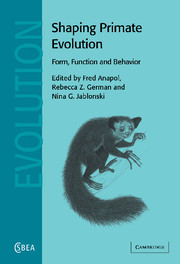Book contents
- Frontmatter
- Contents
- List of contributors
- Preface: shaping primate evolution
- 1 Charles Oxnard: an appreciation
- Part I Craniofacial form and variation
- Part II Organ structure, function, and behavior
- Part III In vivo organismal verification of functional models
- Part IV Theoretical models in evolutionary morphology
- Part V Primate diversity and evolution
- Index
- References
1 - Charles Oxnard: an appreciation
Published online by Cambridge University Press: 10 August 2009
- Frontmatter
- Contents
- List of contributors
- Preface: shaping primate evolution
- 1 Charles Oxnard: an appreciation
- Part I Craniofacial form and variation
- Part II Organ structure, function, and behavior
- Part III In vivo organismal verification of functional models
- Part IV Theoretical models in evolutionary morphology
- Part V Primate diversity and evolution
- Index
- References
Summary
In an extraordinary scientific career extending across the whole second half of the twentieth century and into the twenty-first, Charles Oxnard has placed his unique stamp on nearly every aspect of biological anthropology. He has profoundly influenced the growth and direction of our discipline all around the world, beginning in Europe and moving westward through North America to Asia and Australia. His research accomplishments have been almost as global as his residence patterns. When we think of his work as a whole, we tend to think first of his morphometric work – his lifelong quest for finding reliable ways of taking huge numbers of data or complicated shapes, and crunching them into simpler functions that reveal a small number of underlying patterns reflecting diet, or locomotor behavior, or phylogeny. And most of us think mainly of the works in which Oxnard has applied these approaches to the study of primate and human evolution. But a glance at Oxnard's long bibliography shows an amazingly diverse span of other work, from classical comparative studies of primate anatomy down through studies of growth and development, bone biology, and vitamin B12 metabolism in primates, to the patterns and causes of sexual dimorphism, lower back pain, and osteoporosis in aging. In this introductory chapter, I intend only to sketch briefly the story of what I take to be the central theme in Charles Oxnard's career as a scientist – namely, primate biometrics and its implications for human evolution.
- Type
- Chapter
- Information
- Shaping Primate EvolutionForm, Function, and Behavior, pp. 1 - 8Publisher: Cambridge University PressPrint publication year: 2004



